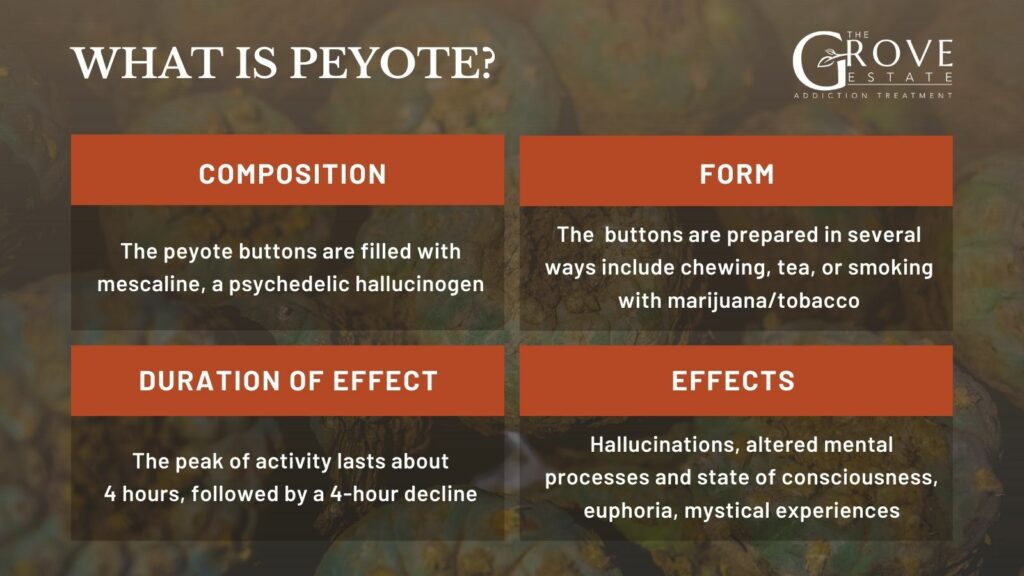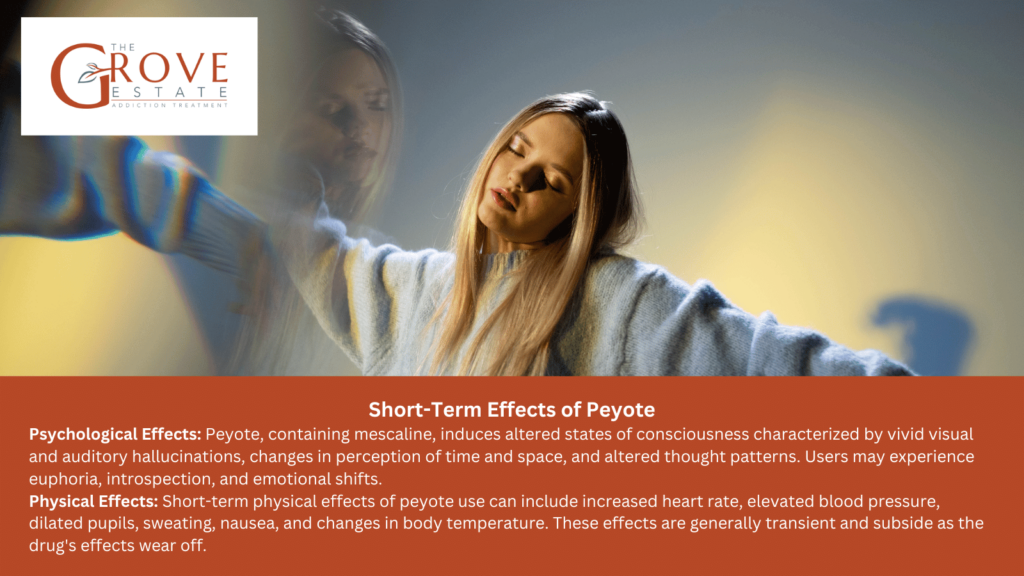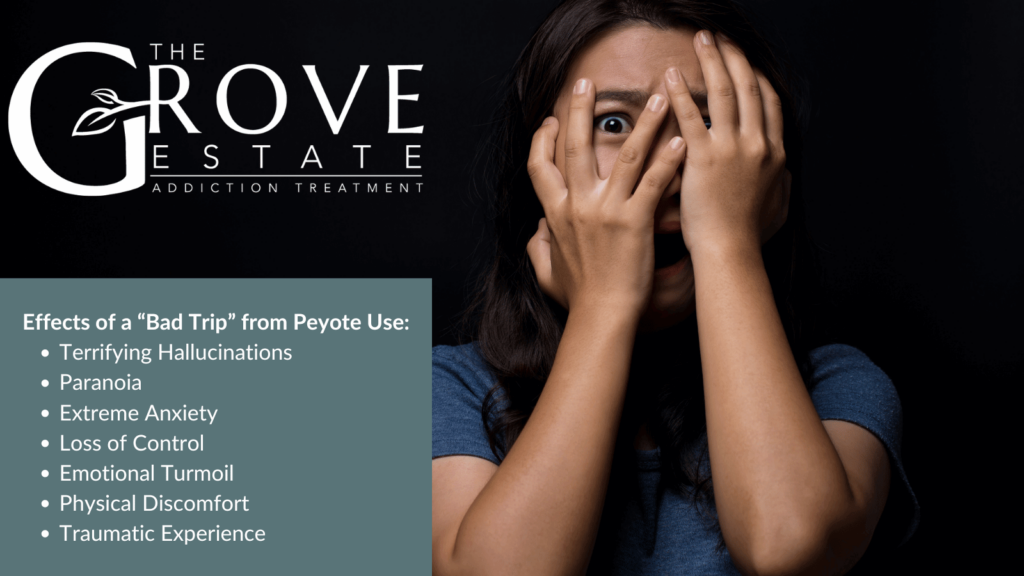Peyote, a small cactus native to the deserts of Southern North America, contains the psychoactive alkaloid mescaline, which can lead to psychological dependence when used repeatedly. Despite its religious significance in Native American rituals, peyote’s psychoactive properties pose risks for addiction. According to the National Library of Medicine (NIH) 5.5 million persons (2.0%) aged 12 or older have used peyote in their lifetime.
The primary effect of peyote is its ability to induce vivid visual hallucinations and altered states of consciousness, which last up to 12 hours. Users often report experiencing a profound sense of connection with the world around them, insight, and euphoria. However, these perceptual changes can also lead to disorientation and a distorted sense of time and space, potentially leading to anxiety or panic in unfamiliar or uncomfortable settings.
The risks of peyote addiction are diverse. The most immediate risks include nausea and increased heart rate, which are common physical responses to the drug. Psychologically, intense experiences lead to disconcerting effects such as anxiety, fear, or paranoia. There’s also the concern about impaired judgment during the high that could lead to accidents or unsafe behaviors. The Substance Abuse and Mental Health Services Administration (SAMHSA) notes that hallucinogens, including mescaline, are less addictive than other drugs but still carry risks, especially among those with a history of mental health issues.
Treatment for peyote addiction primarily focuses on psychological support and counseling, given the lack of physical addiction properties. Psychotherapy is commonly employed to help individuals understand and change their drug-using behaviors. Support groups and therapy also helps users address underlying issues that may contribute to substance use, such as stress, depression, or social pressures. In some cases, particularly where use is heavy and persistent, inpatient treatment programs are recommended to provide a stable environment for recovery.
What is Peyote?

Peyote is a psychoactive cactus containing mescaline, a hallucinogenic compound. It contains the psychoactive alkaloid mescaline, which is responsible for its hallucinogenic effects. Mescaline is a naturally occurring compound that belongs to the phenethylamine class of substances, known for their mind-altering properties. When consumed, mescaline induces altered states of consciousness characterized by vivid visual and auditory hallucinations, changes in perception, and altered thought patterns.
Peyote is commonly abused through various methods, including chewing the buttons, preparing a tea by soaking it in water, or smoking the ground buttons mixed with marijuana or tobacco.
Other names for peyote include:
- Mescal buttons
- Nubs
- Bad Seed
- Cactus
- Hikuri (used in traditional Native American contexts)
- Peyotl (historical term)
In the United States, peyote is classified as a Schedule I controlled substance under the Controlled Substances Act (CSA), except for religious use by members of the Native American Church, which is protected by the American Indian Religious Freedom Act. According to the Substance Abuse and Mental Health Services Administration (SAMHSA), approximately 250,000 Native Americans use peyote for religious purposes each year, emphasizing its cultural significance and legal exemptions.
What are Peyote’s Effects on the Mind and Body?
When consumed, peyote induces altered states of consciousness characterized by vivid hallucinations and changes in perception.

What are the Short-Term Effects of Peyote?
- Psychological Effects: Peyote, containing mescaline, induces altered states of consciousness characterized by vivid visual and auditory hallucinations, changes in perception of time and space, and altered thought patterns. Users may experience euphoria, introspection, and emotional shifts.
- Physical Effects: Short-term physical effects of peyote use can include increased heart rate, elevated blood pressure, dilated pupils, sweating, nausea, and changes in body temperature. These effects are generally transient and subside as the drug’s effects wear off.
What are the Long-Term Consequences of Peyote Addiction?
- Psychological Dependency: While peyote itself is not considered physically addictive, regular use can lead to psychological dependency. Individuals may develop a pattern of relying on peyote to cope with stress, emotional issues, or as a form of escape. This dependency can contribute to a cycle of compulsive use and cravings.
- Mental Health Risks: Prolonged or frequent use of peyote, especially in high doses, can increase the risk of developing psychiatric disorders such as hallucinogen persisting perception disorder (HPPD), characterized by recurring visual disturbances and flashbacks long after drug use has ceased. Additionally, chronic use may exacerbate underlying mental health conditions or trigger new ones, such as anxiety, depression, or psychosis.
Is Peyote Addictive?
Peyote is primarily addictive on a psychological level rather than a physical one. Addiction to peyote, similar to other substance use disorders, involves a complex interplay of both physical and psychological factors.
While peyote use is not typically associated with physical withdrawal symptoms upon cessation, individuals who have used peyote for extended periods may develop a psychological attachment to its intense hallucinogenic and emotional effects. This can lead to a desire to recreate past experiences or “trips,” impacting their daily functioning and overall well-being.
According to the Global Drug Survey the frequency of use and user patterns differ significantly between peyote and other hallucinogens. For instance, peyote is less commonly used recreationally compared to LSD or psilocybin, which are often sought after for their specific psychedelic effects. Although peyote itself may not be deemed physically addictive, it does carry the risk of fostering psychological dependence and misuse.
What are The Risks Associated with Peyote Use?
Peyote’s psychoactive properties also pose significant risks, particularly concerning mental health and the potential for adverse reactions. The American Psychiatric Association’s Position Statement on the Use of Psychedelic Drugs cautions against uncontrolled peyote use due to its potential for inducing psychological distress and exacerbating mental health conditions.
Risks Associated with Peyote Use:
- Impact on Mental Health: Peyote use leads to unpredictable psychological effects, including intense hallucinations, altered perceptions of reality, and emotional upheaval. These experiences will contribute to anxiety, panic attacks, or episodes of psychosis, especially in individuals predisposed to mental health disorders.
- Risk of a Bad Trip: There is a risk for a “bad trip” with peyote, characterized by terrifying hallucinations, paranoia, extreme anxiety, and feelings of losing control. These negative experiences are traumatic and have lasting effects on mental well-being.

While studies suggest therapeutic potential in treating addiction, including alcoholism and substance use disorders, the American Psychiatric Association warns against unregulated or unsupervised use due to risks, lack of standardized dosing, and legal considerations. A study published in the Journal of Psychoactive Drugs reported that approximately 5-10% of individuals who use peyote experience a bad trip or adverse psychological reaction.
What are the Signs of Peyote Misuse?

There are multiple signs to look for when individuals escalate their peyote consumption in terms of dosage or frequency. Prolonged misuse of peyote will have adverse effects on an individual’s life.
Here are 8 signs of Peyote Misuse:
- Increased secrecy or lying about peyote use.
- Neglecting responsibilities or hobbies in favor of using peyote.
- Changes in social circles or withdrawal from family and friends.
- Risk-taking behaviors while under the influence of peyote, such as driving or operating machinery.
- Changes in sleep patterns, either excessive sleeping or insomnia.
- Changes in appetite or weight loss/gain.
- Neglecting personal hygiene or appearance.
- Persistent redness or irritation of the eyes (if smoked) or gastrointestinal issues (if ingested).
What are the Treatment Options for Peyote Misuse?
It’s important for individuals seeking treatment for peyote misuse to undergo a thorough assessment to determine the most appropriate and effective treatment approach tailored to their unique needs and circumstances. Collaboration between mental health professionals, addiction specialists, and medical providers will ensure comprehensive care and support throughout the recovery journey. Here are the treatment options for peyote misuse:
| Treatment Options for Peyote Misuse | Description |
| Cognitive-Behavioral Therapy (CBT) | Helps individuals identify and change negative thought patterns and behaviors related to peyote misuse. Focuses on developing coping strategies and relapse prevention skills. |
| Motivational Enhancement Therapy (MET) | Aims to increase motivation for change and commitment to treatment. Assists individuals in exploring ambivalence about drug use and setting achievable recovery goals. |
| Individual and Group Therapy | Provides a supportive environment for individuals to explore underlying issues contributing to peyote misuse, address emotional challenges, and learn from peers in similar situations. |
| Dual Diagnosis Treatment | Integrates mental health care with substance use disorder treatment for individuals with co-occurring mental health disorders alongside peyote misuse. |
| Psychedelic-Assisted Therapy | Incorporates controlled and supervised use of psychedelics, including peyote, within therapeutic settings to address emotional issues and facilitate personal growth. |
| Holistic Treatment Modalities | Includes mindfulness practices, yoga, art therapy, and nutritional counseling to promote overall well-being and recovery. |
| Medical Monitoring and Support | Involves monitoring and managing physical or psychological symptoms associated with peyote withdrawal or detoxification, with medication if needed. |

What to Expect during Recovery from Peyote Misuse?
During recovery from peyote misuse, individuals can expect a comprehensive approach that addresses various aspects of their well-being. This includes undergoing detoxification under medical supervision to safely eliminate peyote from their system and manage any withdrawal symptoms. Therapy plays a crucial role, encompassing individual, group, and family counseling to explore underlying issues, develop coping strategies, and enhance communication and support networks. Long-term support is also provided through aftercare programs, relapse prevention strategies, and access to community resources, emphasizing sustained efforts towards recovery.
Culturally sensitive care is necessary in peyote misuse recovery. This ensures respect for traditions and beliefs while addressing substance misuse effectively. Additionally, support services are available for friends and family members, offering education, counseling, and guidance on understanding addiction, setting boundaries, and fostering healthy relationships during the recovery journey. Additionally, most state government websites offer comprehensive drug and alcohol resources for individuals seeking assistance.
Are there cultural or spiritual factors that influence the development of peyote addiction?
Yes, cultural and spiritual factors play a significant role in peyote addiction. For some individuals, the use of peyote may be deeply rooted in cultural practices or spiritual beliefs, influencing their relationship with the substance and the development of addiction.
How do peyote addiction patterns differ between indigenous communities and non-indigenous populations?
Peyote addiction patterns vary significantly between indigenous communities and non-indigenous populations. Indigenous communities have traditional practices and rituals involving peyote, while non-indigenous populations tend to misuse the substance for recreational purposes, leading to different addiction patterns and outcomes.
What alternative therapies or interventions are being explored for treating peyote addiction, considering its traditional significance in certain cultures?
Some alternative therapies and interventions for peyote addiction include culturally sensitive counseling, traditional healing practices, and community-based support programs. These approaches aim to respect the substance’s traditional significance while addressing addiction and promoting recovery.
What are the social consequences of chronic peyote use?
Chronic use of peyote can lead to various social consequences, including strained relationships, isolation from non-using peers, and diminished performance at work or school. The altered perceptions and behaviors during and after peyote use can significantly disrupt personal and professional life, leading to social withdrawal and conflict.
Addressing these issues often requires comprehensive recovery programs that include individual counseling, which can help users understand and modify their behaviors and rebuild damaged relationships. This type of counseling is crucial for integrating effective communication skills and enhancing social interactions, which are vital for long-term recovery.
What role does setting play in peyote use experiences?
The setting or environment in which peyote is used significantly influences the user’s experience. A safe, comfortable, and controlled environment can lead to more positive experiences, while an unsafe or stressful environment may increase the likelihood of negative reactions, such as anxiety or paranoia.
Educating users about the importance of setting can help minimize the risks associated with peyote use. Furthermore, for those struggling with addiction, treatment programs often emphasize the need for a supportive and stable environment, which can be facilitated through structured settings like inhalant addiction recovery centers.

Share This Post



